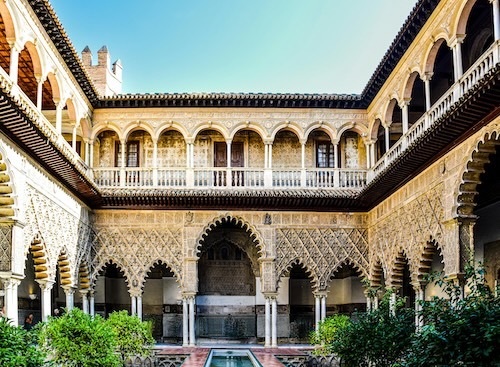Day 1: Alcazar and Cathedral
Morning: Begin your Seville adventure in its most iconic spot: the Royal Alcázar of Seville. This UNESCO World Heritage Site is a mesmerizing blend of Moorish, Gothic, and Renaissance architecture. The intricate tilework, tranquil courtyards, and lush gardens are pure magic. Make sure to visit the Patio de las Doncellas, and don’t miss the Upper Royal Apartments if they’re open.
From the Alcázar, it’s a short walk to the Seville Cathedral, the largest Gothic cathedral in the world. Inside, you’ll find Christopher Columbus’ tomb, grand altarpieces, and dizzyingly high ceilings. Climb the Giralda Tower, originally a minaret, for panoramic views of the city and its orange rooftops.
Afternoon: Step outside into the romantic Barrio Santa Cruz, once Seville’s Jewish quarter. This neighborhood is full of narrow, winding alleys, flower-draped balconies, and hidden plazas. Get lost in its maze-like streets, where every corner leads to something beautiful—a sunlit patio, a quiet fountain, or a tiled courtyard.
Take a break in one of the shaded squares like Plaza de Doña Elvira and enjoy a snack while people-watching. From here, stroll over to Hospital de los Venerables, a baroque gem that’s often overlooked but worth a visit for its peaceful atmosphere and ceiling frescoes.
Evening: In the evening, head to Arenal or back to Santa Cruz for dinner and a relaxed walk along the Guadalquivir River. The golden hour here is absolutely gorgeous. After dark, catch a traditional flamenco show—there’s no better place to experience it than in its birthplace.

Save Tip: Instead of taking an expensive guided tour, download a free audio guide app for the Alcázar and Seville Cathedral. You’ll still get the rich history without paying the extra fee and have the flexibility to explore at your own pace.

Splurge Tip: Join a small-group or private guided tour of the Alcázar to understand the layered history behind each arch and garden—it adds so much to the experience.
Day 2: Riverside Walks, Plazas and Flamenco
Morning: Start your day with a walk along the Guadalquivir River, Seville’s lifeline. Head toward the Torre del Oro, a 13th-century military watchtower. It now houses a small naval museum, but even if you skip the interior, it’s worth seeing for the views of the riverbank and city skyline.
Continue your riverside stroll to Plaza de España, one of Spain’s most beautiful public squares. Built for the 1929 Ibero-American Exposition, this semi-circular plaza is ringed by tiled alcoves representing each Spanish province. Rent a small boat for a short row along the canal, or simply admire the detailed bridges and sweeping architecture.
Next door is Parque de María Luisa, Seville’s most famous park. It’s a dreamy spot for a mid-morning break, filled with exotic trees, fountains, shaded pathways, and even a few peacocks. Bring a drink, find a quiet bench, and soak in the tranquility.
Afternoon: Head into the adjacent Museo de Artes y Costumbres Populares (Museum of Arts and Popular Customs) or the Archaeological Museum, both located within the park. These offer an easy-going yet cultural way to escape the heat and dive into Andalusian life through folk traditions and artifacts.
After your museum visit, make your way to the Triana neighborhood via the Puente de Isabel II (Triana Bridge). Triana has long been the soul of Seville’s flamenco scene and has a completely different vibe—local, gritty, and full of character.
Evening: Spend the evening exploring Calle Betis, a scenic waterfront street lined with colorful buildings, and enjoy riverside views of Seville. This is also a great place to catch another flamenco performance, especially in a smaller, more intimate venue. The Triana version of flamenco is raw, emotional, and unforgettable.

Save Tip: Entry to Plaza de España and Parque de María Luisa is free—and both are stunning enough to feel like top-tier attractions.

Splurge Tip: Experience the soul of Andalusia by attending an intimate flamenco show in the heart of Seville. There’s no better place to witness this passionate art form than in one of the traditional tablaos, where you can enjoy both the fiery dance and heartfelt music up close.
Day 3: Markets, Metropol and Hidden Corners
Morning: Start the day like a local at Mercado de la Encarnación, a traditional food market where you’ll find everything from fresh fruit to jamón ibérico. It’s a vibrant place to observe daily life and try some authentic local snacks.
Above the market is one of Seville’s most intriguing structures: the Metropol Parasol, also known as “Las Setas” (The Mushrooms). This giant wooden structure looks like a surrealist sculpture and has a panoramic walkway on top. It’s a great place to take in sweeping views of the city from above, especially in the morning light.
Next, walk toward Plaza del Salvador, a lively square filled with locals sipping coffee or vermouth. Visit Iglesia del Salvador, a baroque church built on the site of a former mosque—it’s beautiful and steeped in layers of history.singly modern and well-curated.
Afternoon: Wander over to Alameda de Hércules, a wide promenade that blends Seville’s bohemian spirit with modern flair. It’s a perfect spot to relax, explore local art spaces, or browse secondhand bookstalls. The vibe here is young and creative, with a real neighborhood feel.
You can also check out the Palacio de las Dueñas, a stately home once owned by the Duchess of Alba. It’s filled with art, antique furniture, and lovely gardens—and it’s a bit of a hidden gem even among locals.
Evening: Finish your final evening with a stroll around the Setas, which lights up beautifully after dark. Grab a spot at a rooftop bar near Plaza de la Encarnación and toast to three incredible days in Seville.

Save Tip: Climb the Metropol Parasol during the early hours when tickets are cheapest, and skip fancy rooftop bars—local spots nearby are often just as scenic and half the price.

Splurge Tip: Book a Seville rooftop walking tour with tapas and drinks included—it’s a chic way to wrap up your trip and see the city sparkle at night.

If you’re visiting multiple monuments, consider getting the Seville Pass. It bundles entry to the Alcázar, Cathedral, Giralda, and other top sites, with audio guides and skip-the-line access. It saves both time and money.

